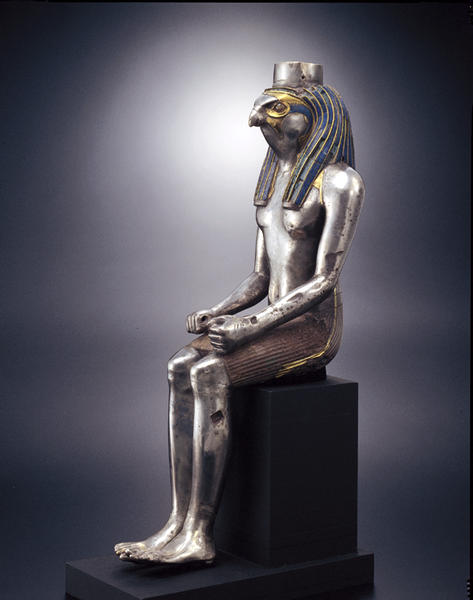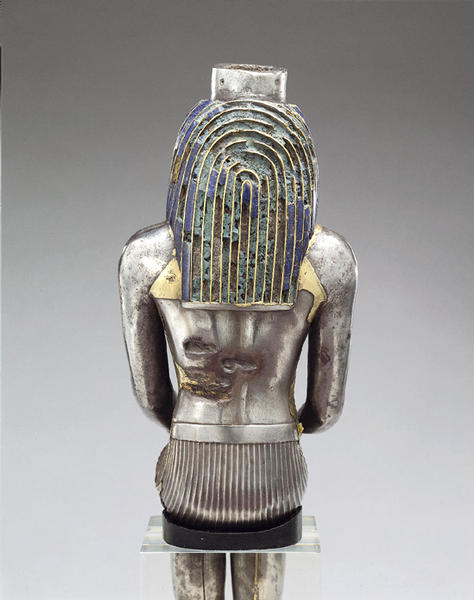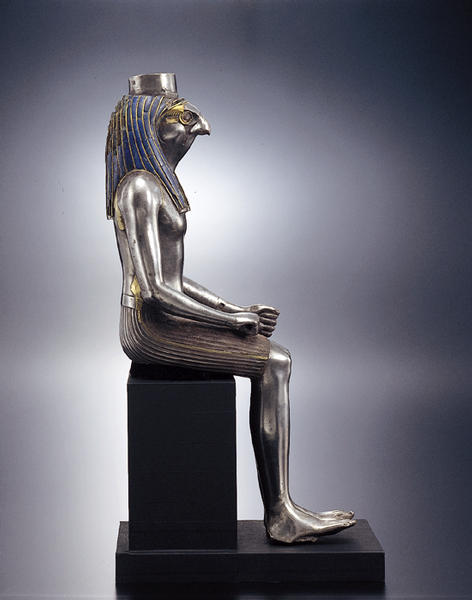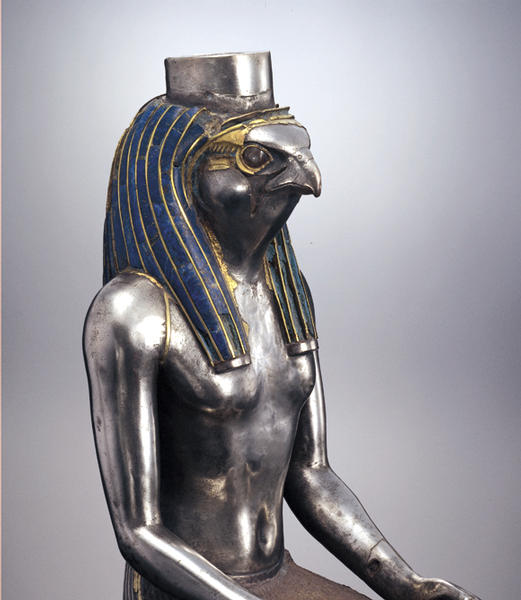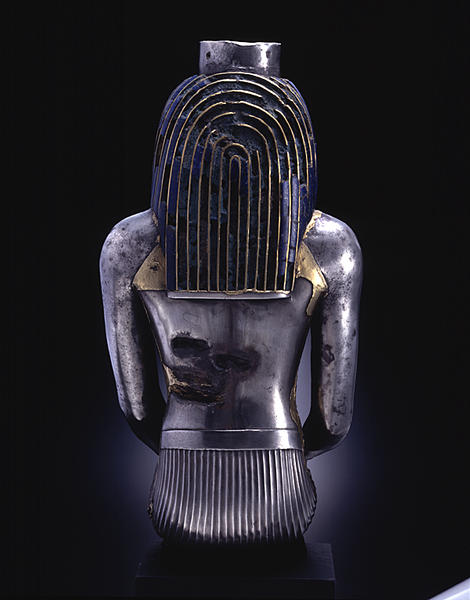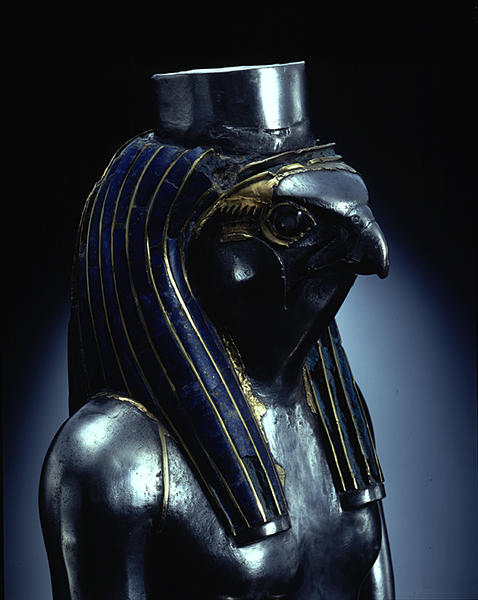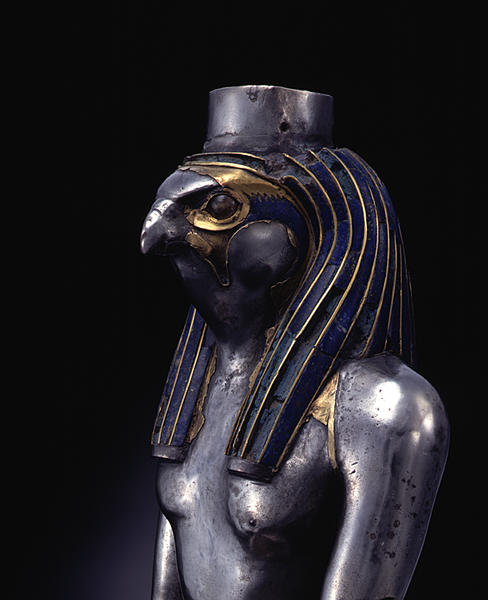隼頭神像
- エジプト
- エジプト新王国時代第19王朝時代初期
- 前1295-前1213年頃
- 銀、金、ラピスラズリ、水晶、エジプシャンブルー
- H-41.9
現在残るエジプトの神像の殆どは建築的意匠や装飾または個人的奉納像としての模刻であり、神殿の至聖所に神そのものとして祀られた礼拝像の遺例は僅少であるが、この像は「骨は銀、肉は金、髪はまことのラピスラズリ」と神話に表現された生ける神そのものの姿を伝えている。本像の総高は記録の残っている多くの神像と同様、今は失われてしまった冠を含めておよそ1キュビットになるが、これは28神にあやかった長さであり、神像にふさわしいものと考えられていたものであろう。
神殿と神像
墓所が人々の住居とは離れた西方におかれたのと対照的に、エジプトの神々の住居、神殿は人々の居住地域のまっただ中にありました。
現世の幸福と永遠の至福を求めてエジプト人はこの神々を礼拝しました。
ふだん神殿の最も奥、至聖所に祀られている生ける神像が、神殿外に運び出される限られた特別の祝祭日にのみ、一般の人々はそれを直に拝むことが許されたのです。
通常は神殿の外部に建築的意匠として作られた石の巨大な神像や、外部の仮の礼拝所に祀られた模刻された神像が礼拝の仮の対象となりました。
神像の成り立ち
この神像は銀、金、ラピスラズリといった高価な貴金属宝石の類で作られていますが、神像がこのような物質で作られる事は正に神宿る像が誕生する事であったのです。
ヒエログリフの「骨」を表わす言葉は「本体」という意味もあり、また「銀」を示す言葉と「体」を示す言葉は大変近い音を持っています。
まず本体としての銀が神の形姿に作られ、それに肉としての金がかぶせられたのです。
そしてその本体たる銀は奉納像のような容物ではなく、神の本体そのものであって稠密でなければならなかったのだと思われます。
この銀はエジプトでは産出せず、おそらく北シリアから輸入されたものと考えられていますが、新王国時代(16-11世紀B.C.)には銀は物の価値を評価する基準となり、金の倍の価値を持っていました。
金は永遠の美しく輝くものの象徴であって、しばしば神像の表面を飾りましたが、とりわけ太陽神は「黄金に輝くもの」と呼ばれ、ラァやホルスが積極的に黄金で表現されたことは充分考えられます。そして更にそれよりも価値の高い銀が神の本体そのものを表現したのです。
神のイメージ
この像は像高42cm、隼の頭部を持った神を象ったもので、髪にはラピスラズリ、眼には水晶の象嵌が施され体は銀の鋳造で作られていますが、その表面に金をかぶせていました。はがれずに残った金も現在確認できます。
鋳造の場合鋳型の内部に芯を入れ、金属を流し込んだ後はその芯を取り去って中空にする事が多いのです。奉納像の場合は、中にその神殿の斎神の現われ又はお使いと
しての動物のミイラを入れて納められることが多かった関係もあって、中身が中空になっていることが殆どです。
しかしこの像は銀塊状に鋳込まれ、更に銀の表面に出来た鋳造時の空(す)に埋銀をして塞ぎ完璧に仕上げた後、その上に金をかぶせているのです。
テーベの新王国時代の王墓(13-12世紀B.C.頃)の壁にはラァにつかえる人間が年老いたラァに対し次のような表明をしている場面が刻まれています。
命と盛栄と健勝の陛下!
しかし 陛下は年老いました。
その骨は銀、肉は金、
髪はまこ とのラピスラズリであります。
この表現はラァについてのものですが、神についてエジプト人が抱いていた心象を垣間見ることができます。
ラァと人間の物語
この種のテキストはテーベのセティI世、ラムセスII世、ラムセスIII世(14-12世紀 B.C.)の王墓の壁に見られます。これは更に古い時代のテキストを踏襲したものと思われ、この神の姿に対する心象は少なくとも新王国には成立していたものと考えられています。
この物語は人間の罪に関連したものです。人類は神に仕えるために創造されました。あるとき人類の創造主・神の失望が人類を壊滅寸前においやりますが、そこから救出されるというものです。
しかしそのテキストの主題は道徳的なものというよりも、むしろ呪術的な力を強調しています。この三つの王墓の壁にはこれらの王の亡骸を守護するまじないも伴っていて、この人類に対する守護は個人の場合にも当てはまると考えられていたのでしょう。
[ありてありたる神ラァ、人と諸神の上に王なりし時 人その神ラァの御前に謀り事を含みて曰く命と盛栄と健勝の陛下!而して陛下はよわいびととなりぬ 汝が骨は銀、肉は金、髪はまことのラピスラズリなりとラァ神、人の己にあらがいて、はかりごとを企てし故にかく曰えりとしりぬ ラァ神 腹心を呼びて 吾が眼を呼びよせよ シュウを テフヌトを ゲブを ヌトを ヌンに吾とともにありし父母を 吾が御祖神であるヌンをも それとわからぬよう人に見られぬよう人をおじけさせることなきよう --]
人は砂漠に逃れラァ神はおのが眼を送ってこれを追いかけさせました。しかしそれでは不十分であったため、ハトホルを遣りました。この女神は遣わされ砂漠で人間を平らげることとなりました。こうしてハトホルのまたのかたちである(人間を駆逐する者としての)セクメトが出来上がったのです。
・James B.Pritchard/ Ancient Near Eastern Texts/ Princeton 1969 ; Ch. Maystre / BIFAO XL 1941
銀製隼頭神像の「発見」
この像が1922年にカイロの美術市場に現われた事については、ツタンカーメン王墓を発掘したハワード・カーターの日記に4月6日付けでその記述があることで有名です。
「銀塊状のホルス神座像 40cm.=16インチ 金板で覆われているがいくらか剥がれている。除錆をすれば良くなるだろう。左の腕と足の膝は壊れている。鬘は金とラピスラズリ、眼は水晶で象嵌されている。露出している銀を見る限りたいへん良い状態だ。」
一方、メトロポリタン美術館のH.E.ウィルキンソン氏からリトゥゴゥ氏へ、先立つ同年の1月20日付で手紙が書かれています。
「--これは明かに銀塊状に鋳造されたもので、錆を落とした部分は大変いい状態だ。全体は酸化物で覆われているが、多分取り除くことが出来るだろう。金は剥ぎ取られてしまっているが、残存している部分を見ると、葉書くらいの厚みがある。鬘はラピスラズリが嵌められているが、半分程残っている。眼はガーネットで作られている。これは本当に注目すべきもので、正に残存する数少ない本当の礼拝像の一つに間違いない。明かにこれはある神殿に祀られていたもので、我々が今日よく見かける奉納像ではない。タノ(美術商)が言うには-この像は壁中に作られた聖龕の中に座っていた。ヒエログリフの書かれているフェイアンスのタイルがその正面に付けられていた-とのことである。--彼はこれを子孫に残す家宝としたいと思っている---」
ガーネット(赤い準貴石)の眼という表現は現実のロッククリスタルの眼と矛盾するようですが、これを修復したシュトゥットガルト・ヴュルテンベルグ博物館のP.アイヒホルン氏によるとこのロッククリスタルは裏から穴があけられそこに黒い石が嵌め込まれて瞳孔を表現し、クリスタルと下地との間には赤い顔料が充填されていた-という報告によって理解出来ます。
カーターが一目でこの像(当時は分厚く錆びていた)がただならぬものであることを見抜いたのは、彼特有の真贋判定法があり、それは作品を目立つ所に置き、毎日幾度となく見、研究をすればするほど、もしそれが贋物であれば次第に悪く見えて来るという訓練を普段から心掛けていたからだったと想像されます。
・メトロポリタン美術館エジプト部門の資料;
・Nicholas Reeves, John H.Taylor/ Howard Carter- Before Tutankhamun/ The British Museum 1992
他の礼拝像例
礼拝像の残存例と言われるものが少ない中で大英博物館のアムン神像(像高23cm)は、新王国時代(1300B.C.頃)のものとされていますが、その本体は銀で造られ冠と襟飾りそして腰にまとうキルトの部分に金が被せられています。
またメトロポリタン所蔵のアムン神像は金塊状の鋳造ですが、むしろ装飾であった可能性が強いと言われています。
・Stephen Quirke, Jeffrey Spencer/ Ancient Egypt / London 1992;
・Nicholas Reeves, John H.Taylor/ Howard Carter- Before Tutankhamun / London 1992
銀製隼頭神像のスタイルと時代
この像の特異性は、古王国型の原型的理想的表現と、全くと言っていい程の筋肉表現の欠落です。プロポーションと図像的表現から言って新王国時代が妥当であろうと考えられています。
近似した体形を持った彫刻として第19王朝(1307-1196)セティI世像(メトロポリタン美術館)が挙げられますが、アビドゥスのセティI世神殿にも近似した隼神の図像表現が見られます。
ラピスラズリと代用品
ルクソール神殿前庭のコンス神(月神)のチャペルに残されたラムセスII世の奉納文によると、彼はエレクトラム(金銀の合金)とあらゆる種類のまことの貴石でコンス神像を造立し奉納したとあります。このように王が神像を造立する場合は本来の材質で造られたことが多かったと思われます。しかし王以外は常にはこのような事は起こらなかったと思われます。
中王朝頃より広く好まれるようになった文学に「シヌヘの物語」がありますが、これは第12王朝センウセルトI世につかえた高官の物語で、その葬儀の表現に「頭部がラピスラズリの金のミイラ覆い」という表現が登場しますが、これは審判においてオシリス(ラアと同一視した意味での)にあやかろうとする習わしであった事が想像されます。
新王国の王墓の壁面に使われている「まことのラピスラズリ」という言葉に対して、研究者から「人工的な青いペーストではない E.A.Wallis Budge/ An Egyptian Hieroglyphic Dictionary / London1920」という但し書きがつき、一方で「人工のラピスラズリ」という言葉も存在しています。
おそらく当時ペーストの代用品が一般的であったことがわかりますが、この場合のラピスラズリという表現は、おそらく青いペーストであったと想像されます。
またフェイアンスや陶製のものが装飾に使われた事も窺われます。メトロポリタン所蔵第12王朝末の高官のミイラ覆はその髪をフェイアンスのビーズで装飾してあります。
この銀製隼頭神像の髪に象嵌されているラピスラズリは大変薄いもので、下地との間は青い顔料(エジプシャンブルーのペースト)で結合されているところから見て、当時ラピスラズリは大変貴重なものであったことが想像されます。
・E.A.Wallis Budge/ An Egyptian Hieroglyphic Dictionary / London 1920;
・A.Lucas/ Ancient Egyptian Materials and Industries/ London1926
・Mahmud Abd El-Razik/ The Dedicatory and Building of Ramesses II in Luxor Temple/
JEA 60 1974, 61 1975;
・J.B.Pritchard/ Ibid.1969;
・Werner Forman, Stephen Quirke/ Hieroglyphs & the Afterlife in Ancient Egypt/ London
1996
ラピスラズリ・ロード
ラピスラズリはアフガニスタン・バダフシャンからエジプトに供給されていたことが最も有力視されていますが、その東北イランから中央アジアに位置する地域とこのエジプトとの間を結んだのはメソポタミア地域であり、紀元前三千年紀古王国時代にはアッカド国、紀元前二千年紀にはバビロニア王国といった南メソポタミアの国が主なる仲介地となりました。
この中央アジアからメソポタミアを経由してエジプトに至る交易のルートは現在「ラピスラズリ・ロード」と呼ばれています。
その関連でエジプトに他の地域からの流入があったとしても、主要なる中継地名を含んだ「バビロンのラピスラズリ」という言葉が特に生まれたものと思われます。
・Georgina Herrmann/ Lapis Lazuli: The Early Phases of its Trade/ Iraq XXX 1968;
・Joan Crowfoot Payne/ Lapis Lazuli in Early Egypt/ Iraq XXX 1968;
・E.A.Wallis Budge/ An Egyptian Hieroglyphic Dictionary / London 1920;
・A.Lucas/ Ancient Egyptian Materials and Industries/ London1926
神像の高さについて
様式上あまり変化の見られない、王朝時代のエジプト美術を対象とするエジプト学の中には、時代に応じたプロポーションの変化を考える分野があります。それは古代エジプト人の残した未完成の壁画や浮彫り、彫刻等に引かれた枠線、基準線から彼等が明確にプロポーションを意識して制作を行った事が分かるからです。
第19王朝頃の神座像のプロポーションは、仮に升目を当てはめてみると、底面から膝まで6目盛、肩まで12目盛となっています。これに従って、この銀製隼頭神の上端までおよそ15.3目盛りほどとすれば、この神像がホルス形の冠を頂いていた場合、他の図像から判断して、その本来の全体の高さは19.3目盛り/ 52.85cm程となります。またオシリス
形の冠を頂いていたとするならば全体の高さは20目盛り/ 54.77cm 程となります。
(Gay Robins 1994 からの演繹による)
デンデラ神殿は古王国からの伝統がありますが、その神殿の資材記録に現われた神像の像高の多くは52.5cm、即ち1ロイヤルキュビットです。このことは、1ロイヤルキュビットが28指幅に相当することから、28神の守護のもとにある象徴とされていた'目出度い'長さであった事と大いに関係があったものと思われます。
28神とは
1)ラァ 2)シュウ 3)ケント 4)ゲブ 5)ヌト 6)オシリス 7)イシス 8)セト 9)ネフテュス 10)ホルス 11)メスタ 12)ハーピ 13)テュアムトゥフ 14)ケブーセヌフ 15)トート 16)セプ 17)ヘク 18)アリマーウア 19)マアテフ 20)アリエネフトチェセフ 21)ヘカ 22)セプチュ 23)セブ? 24)アンヘル 25)ヘルアウア 26)シェプス 27)メヌ 28)ウゥ となっています。
・Gay Robins/ Proportion and Style in Ancient Egyptian Art/ 1994 Texas, Austin
・The Metropolitan Museum of Art Interdepartmental Memorandum - re.Seated figure of falcon-headed god / 17 July 1979;
・Silvie Cauville/ Les Statues Cultuelles de Dendera D'Apres les Inscriptions Parietales/ Bulletin de L'Institut Francais D'Archaeologie Orientale 87 1987
・E.A.Wallis Budge/ An Egyptian Hierogrlyphic Dictionary/ 1920 London
Catalogue Entry
From hieroglyphic texts and temple reliefs we know that the ancient Egyptians placed divine images in the sanctuaries of their temples. Literary and religious texts describe divine and semidivine beings as having limbs overlaid with gold and hair of real lapis lazuli,1 and the Egyptians seem to have fabricated their most important cult images from these precious materials.2 It is not surprising, therefore, that only this one, relatively intact, major cult statue of an ancient Egyptian deity seems to have survived into our own time.3
This seated figure of a falcon-headed deity is of solid-cast silver that was once almost entirely overlaid with sheet gold, some of which is still preserved.4 The hair of the wig is inlaid with lapis lazuli,5 as are the markings on the falcon's face, although much of it is now missing. The deep-set eyes are hemispheres of rock crystal. The pupil of his well-preserved right eye is indicated by a deep drill hole in the back that comes almost to the surface and gives the god the fierce, mesmerizing expression of a bird of prey.6 The ability of Egyptian artists to combine an animal's head with a human body is especially evident in this figure. The transition from the animal to the human form is completely natural; the head and face of the falcon take on an almost human shape without losing the character of the bird.
In the Egyptian pantheon, a number of gods were represented with a falcon's head, the most prominent of whom was Horus. Since the present deity no longer has its crown or other divine attributes, it cannot be identified with certainty, but the figure probably does not represent any of the falcon-headed deities associated directly with the sun or the moon,7 for they would have worn a crown with a sun disk or a crescent moon attached with a mortise and tenon that rested directly on their head. The large cylinder on the Shumei figure's head is more appropriate to the attachment of a double crown,8 which is worn by Horus the Elder (Haroeris) or Horus son of Isis (Harsiesi). The backward slant of the cylinder also leaves open the possibility that the god is Ptah-Sokar-Osiris, who, at least in the early Ramesside period, is represented as a falcon-headed human, wearing a white crown flanked by ostrich plumes.9 Judging from images of seated deities on Egyptian reliefs and in paintings, the silver figure probably held an ankh, the hieroglyphic sign for life, in his right hand and a was-scepter in his left.10 Due to the lack of securely dated sculptural examples of falcon-headed deities before the Graeco-Roman period (332 B.C.-A.D. 395), scholars have dated the silver figure to anywhere from the New Kingdom (about 1550-1069 B.C.) through the Late Dynastic Period (about 715-332 B.C.).11 However, stylistically the proportions of the figure, with its long-waisted, slender torso, seem closest to those of early Ramesside statues, such as the standing alabaster figures of Seti I in the Egyptian Museum, Cairo, and a kneeling figure of the same king in The Metropolitan Museum of Art, New York.12
CHR
l. Such references occur in "Three Tales of Wonder," and in "The Tale of the Shipwrecked Sailor" (see Lichtheim 1973, pp. 220 and 212, respectively). Re is described as having "bones of silver, flesh of gold, and hair of real lapis lazuli" in "The Book of the Cow of Heaven" (see Lichtheim 1976, p. 198).
2. Surviving temple inventories list votive statues of gilded wood (see, for example, Daressy 1908, pp. 2-3). The earliest reference to a divine statue made of silver is from the early New Kingdom stela of Ahmose, where a sphinx of silver is listed among the offerings presented to the god Amun-Re of Karnak (see Sethe 1906, p. 23:8). Ramesses II dedicated statues of "electrum (d'm), real lapis lazuli, and every [kind of ] genuine precious stone" in the temple of Luxor (see Abd el-Razik 1974, p. 160; 1975, pp. 135-36).
3. Smaller images, such as the gold statue of Amun in The Metropolitan Museum of Art (no. 26.7.1412), are probably lavish votive offerings or parts of ceremonial equipment as depicted on temple walls. A cult image was placed in an enclosed shrine in the innermost sanctuary of a temple and was tended daily by priests, who would cleanse and clothe the image and present it with libations and offerings of food.
4. The sheet gold was attached by crimping the edges into grooves cut unobtrusively into the surface of the figure. The most visible of these grooves are the diagonal lines, still filled with gold, extending from the armpits to the wig on the front and back. There are other grooves along the torso beneath the arms, up the back of each leg, and along the sides of the kilt. I am grateful to Deborah Schorsch, associate conservator, Department of Objects Conservation, The Metropolitan Museum of Art, who discussed the manufacture of the statue with me during her examination of it.
5. The bedding material now visible where the lapis lazuli has fallen out of the wig was identified as Egyptian blue by E.-L. Richter of the Staatliche Akademie der bildenden Kste, Stuttgart, who examined the figure in the 1970s.
6. The left eye was restored by Peter Eichhorn of the Wttembergisches Landesmuseum, Stuttgart, when the figure was cleaned and conserved in the 1970s.
7. For example Re-Harakhti, a combination of the sun god Re with Horus of the Horizon, or Khonsu, the moon god, who is sometimes represented with a falcon's head.
8. This is a combination of the red crown of Lower Egypt (the Nile Delta in the north) with the white crown of Upper Egypt (the Nile Valley to the south), symbolizing the union of the Two Lands.
9. The god is represented in this fashion both in the tomb of Seti I in the Valley of the Kings (see Hornung 1991, pp. 140, left, 159, left, where he is called Sokar-Osiris, and p. 208, right) and in the temple he dedicated to Osiris at Abydos (Photograph M 4705 by Harry Burton in the Department of Egyptian Art, The Metropolitan Museum of Art, where the g
